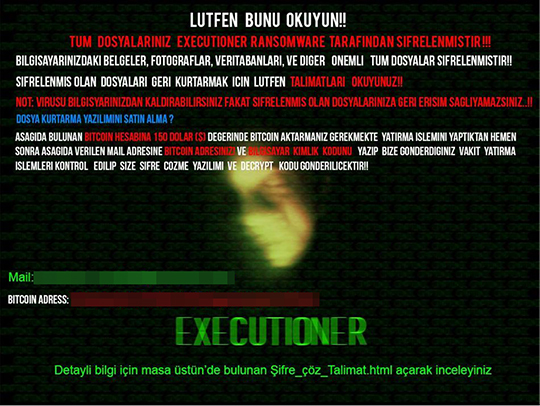RANSOM_EXECUTIONER.A
HEUR:Trojan.Win32.Generic (KASPERSKY); Trojan.Gen.2 (NORTON); Troj/Cryptear-A (SOPHOS_LITE)
Windows


Threat Type: Ransomware
Destructiveness: No
Encrypted: No
In the wild: Yes
OVERVIEW
Dropped by other malware, Downloaded from the Internet
This Ransomware arrives on a system as a file dropped by other malware or as a file downloaded unknowingly by users when visiting malicious sites.
It connects to certain websites to send and receive information.
It encrypts files with specific file extensions. It encrypts files found in specific folders. It drops files as ransom note.
TECHNICAL DETAILS
127,488 bytes
EXE
No
28 Jun 2017
Displays graphics/image, Connects to URLs/IPs, Displays message/message boxes, Encrypts files
Arrival Details
This Ransomware arrives on a system as a file dropped by other malware or as a file downloaded unknowingly by users when visiting malicious sites.
Other System Modifications
This Ransomware sets the system's desktop wallpaper to the following image:
- %User Profile%\cellat.jpg

Download Routine
This Ransomware connects to the following URL(s) to download its component file(s):
- http://i.{BLOCKED}r.com/brpVCDj.jpg
Stolen Information
This Ransomware sends the data it gathers to the following email addresses via SMTP:
- bladekinger@{BLOCKED}mail.com
Other Details
This Ransomware connects to the following website to send and receive information:
- http://www.{BLOCKED}ioner.com/
Ransomware Routine
This Ransomware encrypts files with the following extensions:
- .txt
- .doc
- .docx
- .xls
- .xlsx
- .ppt
- .pptx
- .odt
- .jpeg
- .png
- .csv
- .sql
- .mdb
- .sln
- .php
- .asp
- .aspx
- .html
- .xml
- .psd
- .sql
- .mp4
- .7z
- .rar
- .m4a
- .wma
- .avi
- .wmv
- .csv
- .d3dbsp
- .zip
- .sie
- .sum
- .ibank
- .t13
- .t12
- .qdf
- .gdb
- .tax
- .pkpass
- .bc6
- .bc7
- .bkp
- .qic
- .bkf
- .sidn
- .sidd
- .mddata
- .itl
- .itdb
- .icxs
- .hvpl
- .hplg
- .hkdb
- .mdbackup
- .syncdb
- .gho
- .cas
- .svg
- .map
- .wmo
- .itm
- .sb
- .fos
- .mov
- .vdf
- .ztmp
- .sis
- .sid
- .ncf
- .menu
- .layout
- .dmp
- .blob
- .esm
- .vcf
- .vtf
- .dazip
- .fpk
- .mlx
- .kf
- .iwd
- .vpk
- .tor
- .psk
- .rim
- .w3x
- .fsh
- .ntl
- .arch00
- .lvl
- .snx
- .cfr
- .ff
- .vpp_pc
- .lrf
- .m2
- .mcmeta
- .vfs0
- .mpqge
- .kdb
- .db0
- .dba
- .rofl
- .hkx
- .bar
- .upk
- .das
- .iwi
- .litemod
- .asset
- .forge
- .ltx
- .bsa
- .apk
- .re4
- .sav
- .lbf
- .slm
- .bik
- .epk
- .rgss3a
- .pak
- .big
- wallet
- .wotreplay
- .xxx
- .desc
- .py
- .m3u
- .flv
- .js
- .css
- .rb
- .p7c
- .pk7
- .p7b
- .p12
- .pfx
- .pem
- .crt
- .cer
- .der
- .x3f
- .srw
- .pef
- .ptx
- .r3d
- .rw2
- .rwl
- .raw
- .raf
- .orf
- .nrw
- .mrwref
- .mef
- .erf
- .kdc
- .dcr
- .cr2
- .crw
- .bay
- .sr2
- .srf
- .arw
- .3fr
- .dng
- .jpe
- .jpg
- .cdr
- .indd
- .ai
- .eps
- .pdd
- .dbf
- .mdf
- .wb2
- .rtf
- .wpd
- .dxg
- .xf
- .dwg
- .pst
- .accdb
- .mdb
- .pptm
- .pptx
- .ppt
- .xlk
- .xlsb
- .xlsm
- .xlsx
- .xls
- .wps
- .docm
- .docx
- .doc
- .odb
- .odc
- .odm
- .odp
- .ods
- .odt
- .png
- .jpg
- .rtf
- .mpg
- .mp3
- .png
It encrypts files found in the following folders:
- {Drive Letter}:\
It avoids encrypting files with the following strings in their file path:
- Windows
- Program Files
- Program Files (x86)
It appends the following extension to the file name of the encrypted files:
- .{Random 6 Characters}
It drops the following file(s) as ransom note:
- {Encrypted File Path}\Sifre_Coz_Talimat.html

SOLUTION
9.850
13.500.07
28 Jun 2017
13.501.00
29 Jun 2017
Step 1
Before doing any scans, Windows XP, Windows Vista, and Windows 7 users must disable System Restore to allow full scanning of their computers.
Step 2
Note that not all files, folders, and registry keys and entries are installed on your computer during this malware's/spyware's/grayware's execution. This may be due to incomplete installation or other operating system conditions. If you do not find the same files/folders/registry information, please proceed to the next step.
Step 3
Identify and terminate files detected as RANSOM_EXECUTIONER.A
- Windows Task Manager may not display all running processes. In this case, please use a third-party process viewer, preferably Process Explorer, to terminate the malware/grayware/spyware file. You may download the said tool here.
- If the detected file is displayed in either Windows Task Manager or Process Explorer but you cannot delete it, restart your computer in safe mode. To do this, refer to this link for the complete steps.
- If the detected file is not displayed in either Windows Task Manager or Process Explorer, continue doing the next steps.
Step 4
Search and delete these files
- %User Profile%\cellat.jpg
- {Encrypted File Path}\Sifre_Coz_Talimat.html
Step 5
Reset your Desktop properties
Step 6
Scan your computer with your Trend Micro product to delete files detected as RANSOM_EXECUTIONER.A. If the detected files have already been cleaned, deleted, or quarantined by your Trend Micro product, no further step is required. You may opt to simply delete the quarantined files. Please check the following Trend Micro Support pages for more information:
Step 7
Restore encrypted files from backup.
Did this description help? Tell us how we did.

